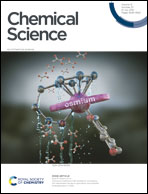Reactions of diborenes with terminal alkynes: mechanisms of ligand-controlled anti-selective hydroalkynylation, cycloaddition and C![[triple bond, length as m-dash]](https://www.rsc.org/images/entities/char_e002.gif) C triple bond scission†
C triple bond scission†
Abstract
The reactions of terminal acetylenes with doubly Lewis base-stabilised diborenes resulted in different outcomes depending on the nature of the ligands at boron and the conformation of the diborene (cyclic versus acyclic). N-heterocyclic carbene (NHC)-stabilised diborenes tended to undergo anti-selective hydroalkynylation at room temperature, whereas [2 + 2] cycloaddition was observed at higher temperatures, invariably followed by a C–N bond activation at one NHC ligand, leading to the ring-expansion of the initially formed BCBC ring and formation of novel boron-containing heterocycles. For phosphine-stabilised diborenes only [2 + 2] cycloaddition was observed, followed by a rearrangement of the resulting 1,2-dihydro-1,2-diborete to the corresponding 1,3-isomer, which amounts to complete scission of both the B![[double bond, length as m-dash]](https://www.rsc.org/images/entities/char_e001.gif) B double and C
B double and C![[triple bond, length as m-dash]](https://www.rsc.org/images/entities/char_e002.gif) C triple bonds of the reactants. The elusive 1,2-isomer was finally trapped by using a cyclic phosphine-stabilised diborene, which prevented rearrangement to the 1,3-isomer. Extensive density functional theory (DFT) calculations provide a rationale for the selectivity observed.
C triple bonds of the reactants. The elusive 1,2-isomer was finally trapped by using a cyclic phosphine-stabilised diborene, which prevented rearrangement to the 1,3-isomer. Extensive density functional theory (DFT) calculations provide a rationale for the selectivity observed.
![Graphical abstract: Reactions of diborenes with terminal alkynes: mechanisms of ligand-controlled anti-selective hydroalkynylation, cycloaddition and C [[triple bond, length as m-dash]] C triple bond scission](/en/Image/Get?imageInfo.ImageType=GA&imageInfo.ImageIdentifier.ManuscriptID=D1SC02081A&imageInfo.ImageIdentifier.Year=2021)


 Please wait while we load your content...
Please wait while we load your content...
![[triple bond, length as m-dash]](https://www.rsc.org/images/entities/h2_char_e002.gif) C triple bond scission
C triple bond scission